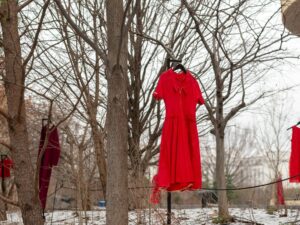On Tuesday, October 26, Dr. Elizabeth Rule (Chickasaw Nation) delivered an impactful lecture on one of the most important contemporary political issues – the missing and murder of Indigenous Women and the legislation that exacerbates this concern.
Dr. Elizabeth Rule is an assistant professor of critical race, gender, and culture studies at American University. Rule’s research concentrates on the intersection of violence against Indigenous women and reproductive justice, as well as how legal structures have explicitly and/or implicitly provoked the oppression and danger endured by Native communities.
The talk, “Seeking Justice for Missing and Murdered Indigenous Women,” lays its groundwork to understand the alarming issue of gender violence against Native women in the U.S. and Canada by situating this issue within the settler colonialism context. Rule opened her talk with a question to the audience, asking whether they are aware of the number of tribes in the U.S. There were multiple guesses, ranging from around 200 to nearly 1,000. The correct answer is 574. There are 574 federally recognized tribes in the US, yet according to Rule, Indigenous tribes are regarded as a racial minority. This misconception has not only led to the erasure of the sovereignty of tribes but also contributed to the violence against Indigenous women and young girls. Rule argues that gender violence against Indigenous women relates back to the issues of land and their occupancy of those spaces, leading to the development of legal and structural institutions to limit the habitation of space and even the cultivation of Indigenous cultures and traditions. For example, disenfranchisement of women from political rights, land property ownership, and reproductive justice left Indigenous women in vulnerable positions where their lives and situations were determined by other people, mostly men.

In addition, forced sterilization is another form of gender-based violence against Indigenous women and young girls. According to Rule, forced sterilization of Indigenous women began in the nineteenth century and continues until today. The data in governmental or official documents are not fully accurate, as the data collection process usually encounters challenges (since so many who experienced this form of violence never got recorded). As a result, the actual numbers of Indigenous women and young girls facing this bigoted and violent act are much higher. This detail, in my opinion, indicates the eugenic discourse that targets the reproductive role of women (I mean Indigenous women’s roles as biological, cultural, and boundary producers). By sterilizing Indigenous women and young girls, settler colonialism aims to end the existence, culture, and values of Indigenous communities. Moreover, homicide is the main cause of death of Indigenous women. The number is alarming; according to the US Department of Justice, the murder rate of Indigenous women is 10 times more than the national average and 84% report having experienced violence in their lifetime.
Rule continued her talk by introducing five pieces of legislation that focus on the violence against Indigenous women, with the earliest one back in 1978, Oliphant v. Suquamish, to the most current one, the Not Invisible Act passed in 2020. This 2020 Act mandates court and law enforcement to combat homicide against Indigenous people. Even though there seems to be some improvement with the handling of gender violence cases, much work still needs to be done to reach justice for Indigenous women and communities.
Rule concluded her talk by relating how COVID-19 has tremendously affected Indigenous women. Not only has the pandemic disproportionately intensified the vulnerability of Indigenous women on social and economic levels, but it also increased domestic violence and mental health issues.
The opening part of the talk, the analysis of how structural systems have exacerbated the violence against and lives of Indigenous women and young girls, as well as the closing live presentation of the healing Jingle Dance and the clothing artifacts signifying the missing and murder of Indigenous women and young girls, have had such a powerful impact on me personally. It alerts me to recognize how limited my knowledge about Indigenous communities is, as well as the need to consider the complexity of Indigenous sovereign structures, which would benefit my work with social justice projects.
Written by Nhi Ly ’22, WGRC student worker
November 4, 2021